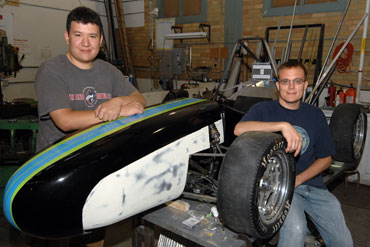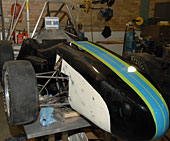Iowa State Formula racing team looks for another top-10 finish
05-08-07

Their race car still needed some paint, decals and mechanical work, but Tony Sartor, left, and Ryan Ellis recently said this year's Iowa State Formula SAE race car will have more horsepower than the team's previous student-designed and student-built cars. Photo by Bob Elbert.
Contacts:
Tony Sartor, Iowa State Formula SAE Team, (563) 508-7342, afroney@gmail.com
Mike Krapfl, News Service, (515) 294-4917, mkrapfl@iastate.edu
Iowa State Formula racing team looks for another top-10 finish
AMES, Iowa -- The talk around the Formula SAE garage at Iowa State University is that this year's student-designed and student-built race car should be better than last year's.
And that's saying something.
Last year's team engineered and drove a mini Formula 1-style, open-wheel racer to a seventh-place finish in an international contest sponsored by the Society of Automotive Engineers. The year before, the team drove to an 18th-place finish.
This year's car is similar to last year's, said Tony Sartor, a May graduate from Bettendorf who studied logistics and supply chain management and is the director of Iowa State's formula race team. The car is still fueled by an E-85 ethanol blend and sponsored by the Ethanol Promotion and Information Council. The chassis and suspension are similar, although the team is testing different suspension springs. And it still takes at least $60,000 in parts and cash to build a competitive car.
But look at this, he said during a recent tour of the car: This year's four-cylinder Kawasaki Ninja engine produces about 90 horsepower. That's about five more horses than last year's engine. And the team will spend more time on tuning the suspension so the car grips the track as it accelerates, brakes and turns.
Will it make a difference on the track?
The team is about to find out. This year's Formula SAE competition is May 16-20 at Ford Motor Company's Michigan Proving Grounds in Romeo. There are 130 teams registered from the United States, Austria, Brazil, Canada, Finland, Japan, Singapore, South Korea, the United Kingdom and Venezuela. Last year's champion, RMIT University of Melbourne, Australia, will be there to defend its title.
It takes a versatile team and car to win. The cars must pass a technical inspection. Judges score team presentations about costs, designs, manufacturing and marketing. There are acceleration and braking tests. There's an endurance and fuel economy race that covers 13.7 miles and reaches top speeds of 65 mph. And there's an autocross, a quick and curvy half-mile course that cars race over at an average speed of 25-30 mph.
Last year's Iowa State team did well on the track, placing third in the endurance race and seventh in the autocross.
Sartor isn't making any promises that this year's team will climb any higher in the standings. There are just so many things that can happen on a race track.
"We could do 10th, we could make the top five or we could totally flop," he said. "We hope to make the top five. But it's so competitive when you get up that high."
Ryan Ellis, a May graduate from Brooklyn who studied industrial technology and is one of the team's drivers, said a top 10 will be tough to repeat. But he still likes the team's race car.
"It has a little more horsepower and we've made slight improvements to the suspension," he said. "I think it will be fast."
-30-
